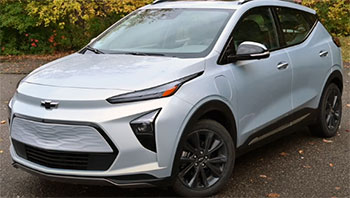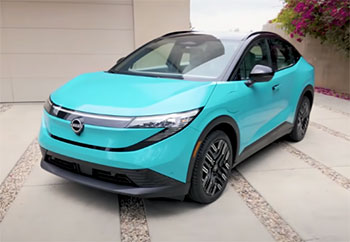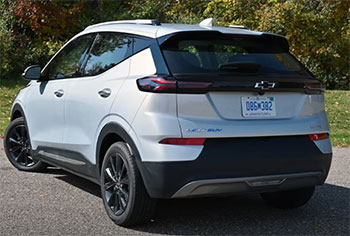As an EV enthusiast, I’ve spent countless hours researching and test-driving electric vehicles to find the perfect balance of range, features, and value. Today, I’m comparing two popular, budget-friendly EVs: the Chevrolet Bolt EV and the Nissan Leaf.
My goal is to share my firsthand insights, breaking down their strengths and weaknesses to help you decide which one fits your lifestyle. With a detailed comparison table, pros and cons, and answers to common questions, this article will guide you through choosing the right EV for your needs.
Comparison Table: Chevrolet Bolt EV vs. Nissan Leaf
| Feature | Chevrolet Bolt EV (2023) | Nissan Leaf (2023) |
|---|---|---|
| Starting MSRP | $25,600 | $28,040 |
| EPA Range | 259 miles | 149 miles (S), 226 miles (SV Plus) |
| Battery Capacity | 66 kWh | 40 kWh (S), 62 kWh (SV Plus) |
| Horsepower | 200 hp | 147 hp (S), 214 hp (SV Plus) |
| Torque | 266 lb-ft | 236 lb-ft (S), 250 lb-ft (SV Plus) |
| DC Fast Charging | 55 kW (100 miles in 30 min) | 62.5 kW (80% in 40-60 min, CHAdeMO) |
| Cargo Space | 16.6 cu ft (seats up), 56.9 cu ft (folded) | 23.6 cu ft (seats up), 30 cu ft (folded) |
| Infotainment | 10.2-inch touchscreen, wireless CarPlay | 8-inch touchscreen, wired CarPlay |
| Advanced Safety | Super Cruise (optional), adaptive cruise | ProPilot Assist (SV Plus), Safety Shield 360 |
| Federal Tax Credit | Not eligible | Up to $7,500 |
My Experience With the Chevrolet Bolt EV

I first slid behind the wheel of a 2023 Chevrolet Bolt EV on a crisp morning, eager to see if this compact hatchback lived up to its reputation as a value-packed EV.
The Bolt’s exterior is unassuming—sleek but not flashy, with a modern, rounded design that feels approachable. Inside, the cabin surprised me with its spaciousness, especially for a compact car.
The 10.2-inch touchscreen was a standout, crisp and intuitive, with wireless Apple CarPlay making my phone integration seamless. The seats, while not luxurious, were comfortable enough for my hour-long test drive through city streets and highways.
The Bolt’s 200 horsepower and 266 lb-ft of torque gave it a peppy feel, especially off the line. Acceleration was smooth and instant, a hallmark of EVs, and it handled curves with confidence, though the suspension felt a tad firm on rough roads. What impressed me most was the 259-mile EPA-estimated range—consistent across all trims—which made me feel confident about longer trips.
Charging at a DC fast charger added about 100 miles in 30 minutes, which is decent but not class-leading. The one-pedal driving mode was a game-changer, letting me slow down and stop just by easing off the accelerator, making city driving a breeze.
However, the interior materials felt a bit budget-oriented, with hard plastics dominating the dashboard. The lack of a federal tax credit was a bummer, as it bumps up the effective cost compared to competitors. Still, the Bolt’s range, tech, and affordability made it a compelling option. I could see myself using it for daily commutes and weekend getaways without worrying about range anxiety.
Pros Of the Chevrolet Bolt EV
- Impressive Range for the Price: The Bolt’s 259-mile range is a standout in the budget EV segment, beating many competitors, including the base Nissan Leaf. It’s perfect for commuters or those planning occasional road trips without needing frequent charging stops.
- Peppy Performance: With 200 horsepower and 266 lb-ft of torque, the Bolt feels lively, especially in urban settings. The instant torque makes merging onto highways or zipping through traffic effortless, and it’s fun to drive.
- Spacious Cargo Area: The Bolt offers 16.6 cubic feet of cargo space with seats up and 56.9 cubic feet with them folded, making it practical for groceries, sports gear, or small furniture hauls.
- Advanced Tech Features: The 10.2-inch touchscreen, wireless Apple CarPlay, and Android Auto are standard, providing a modern, user-friendly experience. Optional Super Cruise hands-free driving (on pre-mapped roads) is a rare feature in this price range.
- One-Pedal Driving: The regenerative braking system allows smooth, intuitive one-pedal driving, reducing brake wear and making stop-and-go traffic less stressful.
- Affordable Starting Price: At $25,600, the Bolt is one of the cheapest EVs available, offering excellent value for its range and features, especially if you don’t need premium trims.
The Bolt’s range was a highlight during my test drive. I drove about 50 miles, mixing city and highway, and the battery gauge barely budged, giving me confidence in its real-world performance. The tech suite, particularly the large touchscreen, felt like a step above what I’d expect in a budget EV. Super Cruise, though optional, intrigued me—I tested it briefly on a compatible highway, and it handled steering and acceleration smoothly, though I stayed vigilant as required. The cargo space was a pleasant surprise; I could easily fit a week’s worth of groceries and a couple of duffel bags. However, I wished for softer interior materials, as the hard plastics reminded me of the car’s budget roots. Overall, the Bolt felt like a practical, fun-to-drive EV that punches above its price tag.
Read More: My Thoughts On BMW X7 Vs. Cadillac Escalade
Cons Of the Chevrolet Bolt EV
- No Federal Tax Credit: Unlike the Nissan Leaf, the Bolt isn’t eligible for the $7,500 federal tax credit, as GM has exceeded its EV sales quota. This makes the effective cost higher, which could sway budget-conscious buyers.
- Budget Interior Materials: The cabin relies heavily on hard plastics, which feel cheap compared to some rivals. While functional, the interior lacks the premium feel of pricier EVs.
- Firm Ride Quality: The suspension is on the stiffer side, making bumps and uneven roads more noticeable. It’s not uncomfortable, but it’s less forgiving than the Leaf’s softer ride.
- Slower DC Fast Charging: The Bolt’s 55 kW DC fast charging speed is modest, adding 100 miles in 30 minutes but lagging behind newer EVs with faster charging capabilities.
- Limited Rear Legroom: Rear legroom measures 36 inches, which is decent but feels cramped for taller passengers, especially compared to the Leaf’s front headroom advantage.
- No Built-In Navigation: The Bolt lacks integrated navigation, relying on smartphone apps for directions and charger locations, which can be less convenient than a built-in system.
During my drive, the firm ride was noticeable on potholed city streets, making me wish for a plusher suspension. The lack of a tax credit stung when I considered the overall cost, especially since the Leaf offers one. The rear seats felt a bit tight when I had friends hop in, and I found myself fumbling with my phone for navigation instead of using an in-car system. The charging speed, while adequate, didn’t wow me—on a road trip, I’d need to plan for slightly longer stops compared to newer EVs. These drawbacks didn’t ruin the experience, but they’re worth considering if you prioritize comfort or incentives.
My Experience With the Nissan Leaf

My test drive of the 2023 Nissan Leaf was equally revealing, offering a different flavor of budget EV.
The Leaf’s design is understated, blending in like a typical hatchback, which I appreciated for its low-key vibe.
The interior felt surprisingly spacious, especially up front, with 41.2 inches of headroom and a comfortable driver’s seat. The 8-inch touchscreen was smaller than the Bolt’s but functional, though wired Apple CarPlay felt less modern.
The Leaf’s cabin had its share of hard plastics, but the overall layout was intuitive and cozy.
Driving the Leaf, I noticed its softer suspension, which soaked up bumps better than the Bolt but made cornering feel a bit floaty. The base model’s 147 horsepower and 236 lb-ft of torque were adequate, but the Leaf Plus (214 hp, 250 lb-ft) felt closer to the Bolt’s zip.
The base Leaf’s 149-mile range was limiting, but the Plus model’s 226 miles was more competitive. Charging was a mixed bag: the CHAdeMO connector, used by the Leaf, is becoming less common, and fast charging (62.5 kW) took 40-60 minutes to reach 80%. The ProPilot Assist system (on SV Plus) was a highlight, offering adaptive cruise and lane-keeping that made highway driving relaxing.
The Leaf’s tax credit eligibility was a big plus, potentially saving $7,500. However, the limited range of the base model and the CHAdeMO standard’s declining support gave me pause. It felt like a solid choice for city dwellers with access to home charging but less ideal for frequent long-distance travelers.
Pros Of the Nissan Leaf
- Federal Tax Credit Eligibility: The Leaf qualifies for a $7,500 federal tax credit, significantly lowering the effective cost, especially for the base model starting at $28,040.
- Spacious Front Cabin: With 41.2 inches of front headroom and 42.1 inches of legroom, the Leaf feels roomy up front, ideal for taller drivers or those who value comfort.
- Smooth and Quiet Ride: The softer suspension delivers a cushioned ride, absorbing bumps well and making city driving comfortable and quiet.
- ProPilot Assist Technology: Available on the SV Plus, ProPilot Assist offers adaptive cruise control and lane-keeping, enhancing highway comfort and reducing driver fatigue.
- One-Pedal Driving: Like the Bolt, the Leaf’s e-Pedal mode allows one-pedal driving, simplifying city commutes and maximizing regenerative braking efficiency.
- Affordable Base Model: The base Leaf S starts at $28,040, and with the tax credit, it’s one of the most affordable EVs, appealing to budget buyers.
The Leaf’s smooth ride was a standout during my test drive, especially on bumpy suburban roads where it felt more forgiving than the Bolt. The front cabin’s spaciousness was a win—I’m 6 feet tall, and I had plenty of room to stretch out.
ProPilot Assist made a highway stint feel effortless, keeping me centered in my lane and maintaining a safe distance from other cars. The tax credit was a major draw; when I crunched the numbers, the Leaf S felt like a steal. The e-Pedal mode was intuitive, and I loved how it brought the car to a complete stop without touching the brake. For city driving, the Leaf felt like a practical, budget-friendly gem.
Cons Of the Nissan Leaf
- Limited Range in Base Model: The base Leaf’s 149-mile range is underwhelming, making it less suitable for long trips or drivers with range anxiety.
- CHAdeMO Charging Standard: The Leaf uses CHAdeMO, which is less common than the CCS standard, potentially limiting fast-charging options as infrastructure shifts.
- Slower Charging Times: DC fast charging takes 40-60 minutes to reach 80%, slower than some competitors, and Level 2 charging can take up to 11.5 hours.
- Limited Cargo Space: With 23.6 cubic feet (seats up) and 30 cubic feet (seats folded), the Leaf’s cargo area is smaller than the Bolt’s, especially when seats are down.
- Less Powerful Base Model: The base Leaf’s 147 horsepower feels adequate but lacks the Bolt’s punch, making acceleration less exciting.
- Wired Smartphone Integration: The Leaf’s wired Apple CarPlay and Android Auto feel dated compared to the Bolt’s wireless setup, requiring cables for connectivity.
The base Leaf’s range was a letdown; I worried about making a 100-mile round trip without a charge. The CHAdeMO connector concerned me, as I noticed fewer stations supporting it near my area. Cargo space was another issue—my test load of grocery bags and a stroller felt cramped with the seats up. The wired CarPlay setup was a minor annoyance, as I prefer a cable-free experience. While the Leaf Plus addressed some of these issues, its higher price narrowed the cost gap with the Bolt, making the choice less clear-cut.
Weighing the Decision: Bolt vs. Leaf
Choosing between the Chevrolet Bolt EV and Nissan Leaf came down to my priorities as a driver. The Bolt’s 259-mile range was a major advantage, especially since I occasionally drive 150 miles to visit family. Its peppy performance and spacious cargo area made it feel like a versatile daily driver, and the 10.2-inch touchscreen added a modern touch. However, the lack of a tax credit and the firm ride were drawbacks, especially since I value comfort on long drives. The interior’s budget materials also reminded me I wasn’t in a premium EV.

The Leaf, on the other hand, won me over with its $7,500 tax credit, which made the base model feel like a bargain. The softer ride and spacious front cabin were perfect for my daily city commutes, and ProPilot Assist added a layer of convenience on highways. But the base model’s 149-mile range felt restrictive, and the CHAdeMO charging standard worried me about future compatibility. The Leaf Plus was more appealing with its 226-mile range, but its price crept closer to the Bolt’s, reducing the tax credit’s impact.
I also considered practical factors like charging infrastructure. My city has a decent mix of CCS and CHAdeMO stations, but CCS is more common, giving the Bolt an edge for road trips. Home charging wasn’t an issue, as both support Level 2 chargers, but the Bolt’s faster Level 2 charging (7 hours vs. 11.5 for the Leaf Plus) was a plus for my busy schedule. Safety features were comparable, with both offering adaptive cruise and lane-keeping, but the Bolt’s optional Super Cruise felt like a futuristic perk, even if it’s limited to certain roads.
Cost was a big factor. The Bolt’s $25,600 starting price was lower, but without the tax credit, the Leaf S (effectively $20,540 after credit) was cheaper upfront. However, the Bolt’s longer range and better cargo space made it feel like a better long-term investment. I also thought about resale value: the Leaf retains slightly more value (losing 55.6% over five years vs. 57.6% for the Bolt), but the Bolt’s reliability rating (7.1/10 vs. 6.9/10) gave me confidence in its longevity.
Ultimately, my decision hinged on how I’d use the car. If I were strictly a city driver with access to home charging and valued upfront savings, the Leaf’s tax credit and comfy ride would win. But for my mix of city and highway driving, plus the need for more range and cargo flexibility, the Bolt felt like the better fit. It’s not a clear winner—both are solid EVs—but the Bolt’s range and tech tipped the scale for me.
Read More: My Thoughts On Ford Escape Vs. Mazda CX-5
Frequently Asked Questions (FAQ)
The $1,400 rebate refers to occasional promotional offers from Chevrolet, typically tied to specific trims or financing deals. Check with dealers for current availability, as it’s not a federal tax credit.
The Leaf’s main disadvantages are its limited base model range (149 miles), outdated CHAdeMO charging standard, and smaller cargo space compared to competitors like the Bolt.
Nissan has not officially confirmed discontinuation, but reports suggest the Leaf may be phased out in the coming years as Nissan focuses on new EV models.
Nissan is reportedly developing a next-generation EV, possibly a crossover, to replace the Leaf, with improved range and CCS charging, expected around 2026.
Conclusion: For Chevrolet Bolt EV and Nissan Leaf
You’re probably wondering which EV is the right pick for you, and I get it—it’s a tough call. The Chevrolet Bolt EV shines with its 259-mile range, peppy performance, and spacious cargo area, making it ideal if you need a versatile, long-range EV for commutes or road trips. But the lack of a tax credit and firm ride might give you pause. The Nissan Leaf, with its $7,500 tax credit and cushy ride, is a budget-friendly gem for city drivers, though its base model’s range and CHAdeMO charging limit its appeal. Test-drive both to see what fits your vibe—I lean toward the Bolt for its range, but the Leaf’s savings are hard to ignore.

